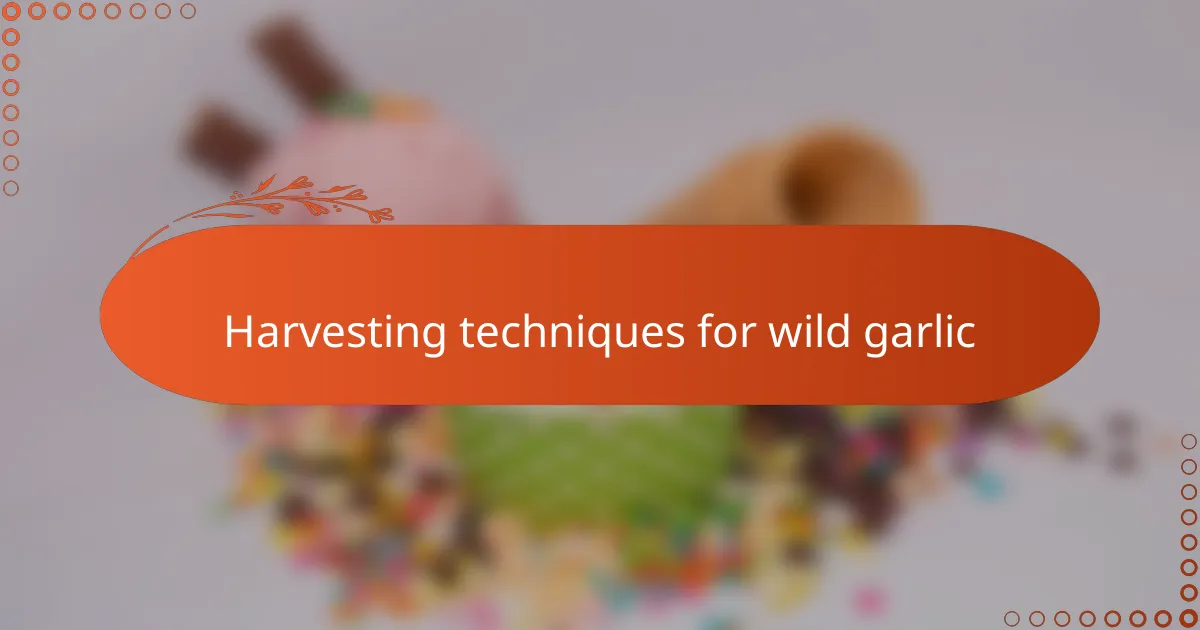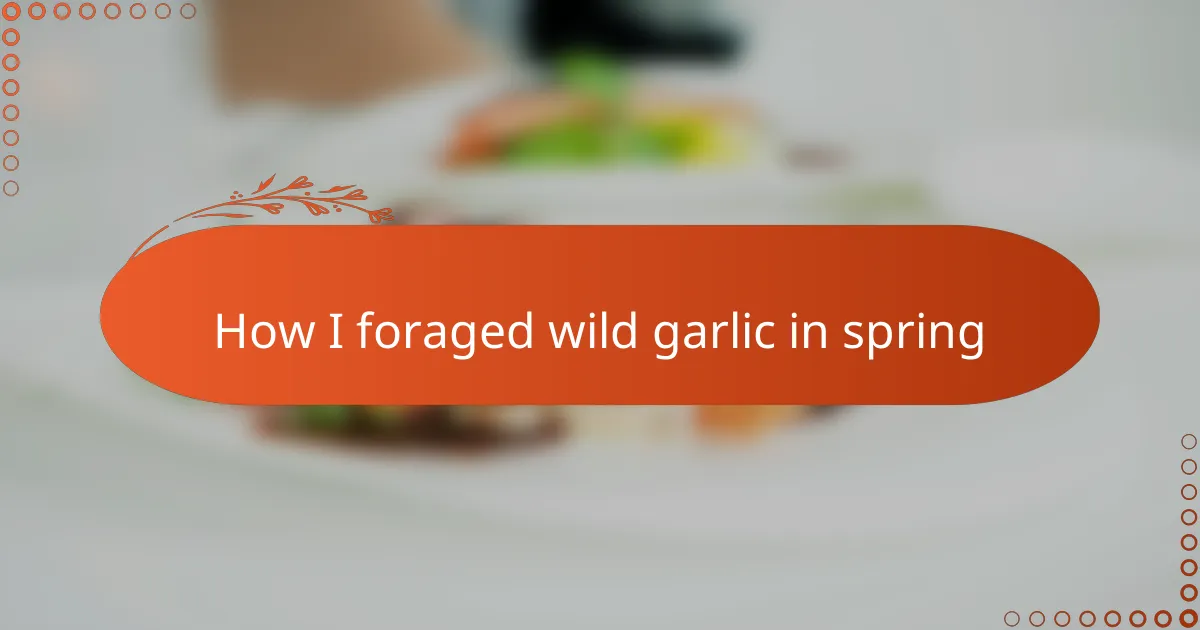Key takeaways
- Wild garlic, or ramsons, is identifiable by its strong garlic scent and smooth, lance-shaped green leaves that bloom with white flowers in spring.
- Foraging requires proper tools such as a sharp knife and a basket, along with safety precautions like wearing gloves and ensuring the picking area is free from pesticides.
- Ideal foraging locations include shady woodlands with rich, moist soil, often near streams, where wild garlic thrives.
- Simple recipes like wild garlic pesto or adding it to salads and scrambled eggs can elevate meals with its fresh, vibrant flavor.

What is wild garlic
Wild garlic, also known as ramsons, is a leafy green plant that bursts into life during early spring. When I first stumbled upon it, its strong, fresh garlic aroma immediately caught my attention—almost impossible to miss if you know what to look for. Have you ever walked through a forest and suddenly noticed a delightful garlicky scent underfoot? That’s wild garlic calling out.

How to identify wild garlic in spring
One of the first things I learned about identifying wild garlic in spring is to trust your nose before your eyes. The unmistakable garlic scent hits you even before you spot the leaves, making it feel like a little treasure hunt in the woods. Have you ever paused just because the air smelled so fresh and inviting?
Visually, wild garlic leaves are smooth, lance-shaped, and a vibrant green that seems almost to glow in the dappled sunlight. When I saw those broad, pointed leaves carpeting the forest floor, I knew I was in the right place. It’s that lush, soft greenery that makes you want to bend down and take a closer look.
Then there are the delicate white flowers that bloom in clusters later in spring. I’ve found that spotting these flowers is like nature’s confirmation that what you found isn’t just any leafy plant but truly wild garlic. It’s a beautiful bonus that feels like a reward after the foraging effort.

Tools and safety for foraging
When I started foraging wild garlic, I quickly realized that a sharp knife and a sturdy basket were my best friends. Having a knife made it easy to harvest the leaves without damaging the plant, while the basket kept everything fresh and airy. Have you ever tried stuffing wild garlic leaves into a flimsy plastic bag? It just turns them into a soggy mess, and that’s no fun at all.
Safety is something I always keep top of mind during my foraging trips. One time, I almost grabbed a handful of leaves without double-checking, only to realize later they looked similar but weren’t wild garlic at all. That experience taught me the importance of knowing the plant in detail and avoiding areas treated with pesticides or near busy roads. Do you ever stop to think about where you’re picking your greens? It really matters.
I also like to wear gloves when I’m out in the woods, especially during spring when the ground can be damp and unpredictable. It’s a simple step that saves a lot of dirt under my nails and protects me from any hidden irritants. Plus, good footwear is a must—muddy trails are part of the adventure, but slipping is not. Have you ever ended a foraging day with sore feet? I certainly have, and it’s a lesson I don’t forget.

Best locations to forage wild garlic
When I first started searching for wild garlic, I found the best spots were usually shady woodlands with moist, rich soil. Have you ever noticed how those peaceful forest floors, especially near streams or damp hollows, seem to host a carpet of fresh green? That’s exactly where wild garlic loves to thrive—it’s like the perfect little ecosystem just waiting for you to discover it.
One time, I stumbled upon a patch beneath a cluster of old oak trees, and the aroma was so strong that I knew I’d hit the jackpot without even seeing the leaves at first. It’s these cool, sheltered areas with partial sunlight that create the ideal conditions. Have you ever walked through a place so quiet and untouched that you felt like you were the first to set foot there in years? That’s often the kind of place wild garlic calls home.
I’ve also learned to check nearby hedgerows and riverbanks, especially in early spring before other plants fully emerge. These locations tend to stay damp and cool longer, giving wild garlic a competitive edge. It makes me wonder—how many hidden pockets of wild garlic have we all passed by without realizing? Next time you’re out, take a closer look where the earth still feels moist and the light gently filters through the trees.

Harvesting techniques for wild garlic
Harvesting wild garlic requires a gentle touch to ensure the plant keeps thriving. When I gather the leaves, I always snap or cut just the outer leaves rather than uprooting the entire plant. Have you ever noticed how careful handling not only preserves the patch but also feels like a respectful nod to nature?
Timing plays a big role too. I tend to pick wild garlic early in the morning when the leaves are crisp and full of flavor. There was one chilly spring dawn I remember, the air still cold, and each leaf seemed to sparkle with dew—that freshness made all the difference in my cooking later.
Another trick I’ve found useful is to avoid flowering plants if I want the leaves to be tender and mild. Once those white blossoms start to open, the leaves become a bit tougher and less pleasant to eat. Have you ever come across wild garlic that tasted a little too strong or fibrous? That’s usually why, and harvesting before the flowers pop helps me avoid that every time.

Preparing wild garlic for cooking
Preparing wild garlic for cooking feels like a small ritual that connects me to the whole foraging experience. Once I bring the leaves home, I give them a gentle rinse in cold water to wash away any forest debris or tiny insects. Have you ever been surprised by a little bug tucked inside a leaf? It’s a reminder that these greens come straight from nature’s pantry.
After washing, I like to pat the leaves dry with a clean kitchen towel or use a salad spinner—this little step keeps the leaves crisp and prevents sogginess in my dishes. I’ve found that properly dried wild garlic holds its vibrant flavor better and blends more smoothly into sauces and pestos. Doesn’t a fresh, lively taste make all the difference in your cooking?
Sometimes, when I’m short on time, I chop the leaves roughly right after drying, which makes it easier to toss them directly into my recipes. But if I plan to store some for later, I prefer keeping the leaves whole in a paper-lined container inside the fridge. That way, they stay fresh longer without wilting or turning slimy. Have you tried storing wild garlic before? It can be a little tricky, but this method has worked well for me.

Simple wild garlic recipes for beginners
When I first started cooking with wild garlic, I kept it simple—just a handful of fresh leaves tossed into a basic salad. The vibrant green color and gentle garlic punch instantly elevated the dish, making me wonder why I’d never used it before. Have you tried sprinkling wild garlic over toasted bread with a drizzle of olive oil? It’s like an easy gourmet upgrade that anyone can master.
One of my go-to beginner recipes is wild garlic pesto. Grinding handfuls of leaves with nuts, Parmesan, and a splash of olive oil is surprisingly quick, and the result tastes like a fresh burst of spring in every bite. You don’t need fancy equipment, just a blender or mortar and pestle—and suddenly, you’ve got a versatile sauce to jazz up pasta, sandwiches, or roasted veggies. Have you ever made pesto from scratch? It’s a satisfying way to bring wild garlic into your kitchen.
Sometimes, I like to keep things even simpler by stirring chopped wild garlic into scrambled eggs. The warmth gently mellows the flavor, creating a subtle garlicky note that feels comforting and new all at once. Is there anything better than a quick, flavorful breakfast that reminds you of the forest floor from where those leaves came? For me, that little connection to nature is what makes cooking with wild garlic truly special.



